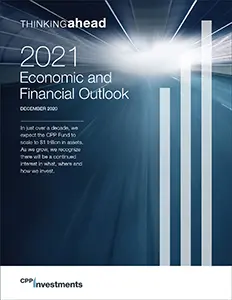In 2021, we expect COVID-19 to continue to be the biggest factor in the global economy.
The ripple effects will be far-reaching, from the adequacy of governments’ response to impacts of this shock on the workforce to changes in the pattern of global trade.
In our outlook for 2021, we highlight several of these knock-on effects and consider possible long-term outcomes.
Read our 2021 Economic and Financial Outlook
The evolution of the COVID-19 pandemic was the biggest global event of 2020 and will remain one of the most important considerations shaping the investment landscape for 2021 and beyond.
Our 2021 Outlook highlights the continuing ripple effects of COVID-19 and considers possible long-term outcomes.
Four Themes for 2021
![]()
Evolution of COVID-19 and its impact on the economy
- It’s tempting to think the rapid arrival of effective vaccines will mark the beginning of the end of the pandemic. Instead, it’s more likely to mark the beginning of a long transition back to something approaching normal as people only gradually gain confidence they can resume customary activities without endangering themselves or others.
- Advanced economies are likely to experience wide variation in real GDP growth during the recovery, based on three factors: the spread of the disease, the pre-existing structures of economies and local policy responses.
- COVID-19 will accelerate changes that were already underway in the world economy, from global inequalities to transformation of logistic networks to technological innovation.
![]()
Productivity, scarring and implications for potential growth
- The COVID-19 shock could have a continuing adverse impact on productivity growth, scarring economies far into the future.
- Faced with greater uncertainty about potential structural changes in the economy and weak demand, some firms may postpone or cancel their investment plans. On the other hand, the rapid policy response, low interest rates and relatively robust recovery in equity markets and the economy could also encourage a faster resumption of original plans for business investment.
- The labour market recovery has been uneven across industries, workers and genders, with women bearing a heavier burden from the shock. A failure of female workforce participation rates to recover to their pre-pandemic trends would have long-term negative effects on productivity growth.
![]()
Monetary and fiscal policy and debt sustainability
- The policy response to COVID-19 has been unprecedented. Within weeks of the WHO declaring COVID-19 a pandemic, every major developed market central bank had lowered its policy rates to, or near, their effective lower bounds.
- New government fiscal measures in 2020 amount to over US$5 trillion, or 6% of global GDP. The fiscal response will likely push the global public debt-to-GDP ratio above 100%.
- As the recovery continues, we will pay close attention to the evolving stance of fiscal and monetary policy and possible modifications to policy frameworks, particularly on the monetary side.
![]()
Deglobalization, trade and the trade war
- The decades-long process of increasing the integration of economic activity through international trade had lost momentum, even before the pandemic.
- Despite the setback in trade globalization, the pace of trade and value-chain integration has accelerated at a regional level, particularly in Asia. This trend of regional integration could further accelerate, with additional regional trade agreements being finalized.
- Emerging markets, most notably China, have increased their share of global exports since the 1990s.
In 2021, we expect COVID-19 to continue to be the biggest factor in the global economy.
The ripple effects will be far-reaching, from the adequacy of governments’ response to impacts of this shock on the workforce to changes in the pattern of global trade.
In our outlook for 2021, we highlight several of these knock-on effects and consider possible long-term outcomes. Read our 2021 Economic and Financial Outlook The evolution of the COVID-19 pandemic was the biggest global event of 2020 and will remain one of the most important considerations shaping the investment landscape for 2021 and beyond. Our 2021 Outlook highlights the continuing ripple effects of COVID-19 and considers possible long-term outcomes. Four Themes for 2021 Evolution of COVID-19 and its impact on the economy It’s tempting to think the rapid arrival of effective vaccines will mark the beginning of the end of the pandemic. Instead, it’s more likely to mark the beginning of a long transition back to something approaching normal as people only gradually gain confidence they can resume customary activities without endangering themselves or others. Advanced economies are likely to experience wide variation in real GDP growth during the recovery, based on three factors: the spread of the disease, the pre-existing structures of economies and local policy responses. COVID-19 will accelerate changes that were already underway in the world economy, from global inequalities to transformation of logistic networks to technological innovation. Productivity, scarring and implications for potential growth The COVID-19 shock could have a continuing adverse impact on productivity growth, scarring economies far into the future. Faced with greater uncertainty about potential structural changes in the economy and weak demand, some firms may postpone or cancel their investment plans. On the other hand, the rapid policy response, low interest rates and relatively robust recovery in equity markets and the economy could also encourage a faster resumption of original plans for business investment. The labour market recovery has been uneven across industries, workers and genders, with women bearing a heavier burden from the shock. A failure of female workforce participation rates to recover to their pre-pandemic trends would have long-term negative effects on productivity growth. Monetary and fiscal policy and debt sustainability The policy response to COVID-19 has been unprecedented. Within weeks of the WHO declaring COVID-19 a pandemic, every major developed market central bank had lowered its policy rates to, or near, their effective lower bounds. New government fiscal measures in 2020 amount to over US$5 trillion, or 6% of global GDP. The fiscal response will likely push the global public debt-to-GDP ratio above 100%. As the recovery continues, we will pay close attention to the evolving stance of fiscal and monetary policy and possible modifications to policy frameworks, particularly on the monetary side. Deglobalization, trade and the trade war The decades-long process of increasing the integration of economic activity through international trade had lost momentum, even before the pandemic. Despite the setback in trade globalization, the pace of trade and value-chain integration has accelerated at a regional level, particularly in Asia. This trend of regional integration could further accelerate, with additional regional trade agreements being finalized. Emerging markets, most notably China, have increased their share of global exports since the 1990s.
The ripple effects will be far-reaching, from the adequacy of governments’ response to impacts of this shock on the workforce to changes in the pattern of global trade.
In our outlook for 2021, we highlight several of these knock-on effects and consider possible long-term outcomes. Read our 2021 Economic and Financial Outlook The evolution of the COVID-19 pandemic was the biggest global event of 2020 and will remain one of the most important considerations shaping the investment landscape for 2021 and beyond. Our 2021 Outlook highlights the continuing ripple effects of COVID-19 and considers possible long-term outcomes. Four Themes for 2021 Evolution of COVID-19 and its impact on the economy It’s tempting to think the rapid arrival of effective vaccines will mark the beginning of the end of the pandemic. Instead, it’s more likely to mark the beginning of a long transition back to something approaching normal as people only gradually gain confidence they can resume customary activities without endangering themselves or others. Advanced economies are likely to experience wide variation in real GDP growth during the recovery, based on three factors: the spread of the disease, the pre-existing structures of economies and local policy responses. COVID-19 will accelerate changes that were already underway in the world economy, from global inequalities to transformation of logistic networks to technological innovation. Productivity, scarring and implications for potential growth The COVID-19 shock could have a continuing adverse impact on productivity growth, scarring economies far into the future. Faced with greater uncertainty about potential structural changes in the economy and weak demand, some firms may postpone or cancel their investment plans. On the other hand, the rapid policy response, low interest rates and relatively robust recovery in equity markets and the economy could also encourage a faster resumption of original plans for business investment. The labour market recovery has been uneven across industries, workers and genders, with women bearing a heavier burden from the shock. A failure of female workforce participation rates to recover to their pre-pandemic trends would have long-term negative effects on productivity growth. Monetary and fiscal policy and debt sustainability The policy response to COVID-19 has been unprecedented. Within weeks of the WHO declaring COVID-19 a pandemic, every major developed market central bank had lowered its policy rates to, or near, their effective lower bounds. New government fiscal measures in 2020 amount to over US$5 trillion, or 6% of global GDP. The fiscal response will likely push the global public debt-to-GDP ratio above 100%. As the recovery continues, we will pay close attention to the evolving stance of fiscal and monetary policy and possible modifications to policy frameworks, particularly on the monetary side. Deglobalization, trade and the trade war The decades-long process of increasing the integration of economic activity through international trade had lost momentum, even before the pandemic. Despite the setback in trade globalization, the pace of trade and value-chain integration has accelerated at a regional level, particularly in Asia. This trend of regional integration could further accelerate, with additional regional trade agreements being finalized. Emerging markets, most notably China, have increased their share of global exports since the 1990s.









